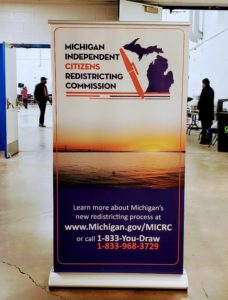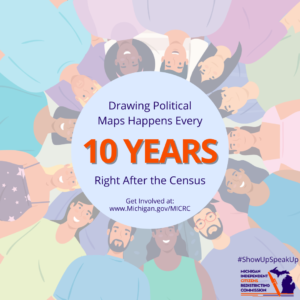By Tom Travis
Residents stood up and spoke up Tuesday at a public hearing at The Dort Federal Event Center on Lapeer Road with their thoughts and comments about redistricting in Michigan. Standing at a podium, residents addressed the new 13-member Independent Citizens Redistricting Commission (ICRC), who sat at tables on an elevated stage looking down on the speakers. Masks were required and social distancing was followed.
Flint resident and local activist Claire McClinton was among those addressing the ICRC at the hearing, which ran from 1 to 8 p.m. in a large basement auditorium room. She reminded them, “We were trying to save our democracy when we overturned Public Act 4. And we are going to be watching you to see if you overturn the hard work that we’ve done to get fairness in this state.”

Flint resident Claire McClinton speaks to the 13-member redistricting commission at the public hearing on Tuesday. (Photo by Tom Travis)
[As explained in a Detroit News report, Public Act 4 allowed the governor to appoint and oversee an emergency manager without the input of voters, the state Senate or other elected government officials. Public Act 4 was passed by the Michigan Legislature and signed by the governor in six weeks, eliminating the potential for voter input. That act played a huge role in the Flint Water Crisis, which erupted during the tenure of an emergency manager appointed by then-Gov. Richard Snyder.]
McClinton was there with another fervent Flint community activists, Claudia Perkins-Milton and Joelena Freeman.
“The results of redistricting ultimately results in the amount of resources that the city receives and the caliber of representation it receives,” said former Flint Mayor Woodrow Stanley, one of about 50 residents participating in the event. “So it’s critical. I’ve always said it’s right up there with oxygen, in terms of things you need to exist.”

Residents gathered to engage with the 13-member redistricting commission at a public hearing in the basement of The Dort Federal Event Center on Lapeer Road. (Photo by Tom Travis)
Michigan will lose one congressional seat due to population decrease
According to the 2020 Census, Michigan is expected to lose a congressional seat in 2022 due to a population decrease. With the 2020 Census completed, Michigan has been going through the process of redistricting or redrawing of congressional districts.

A banner welcoming participants at the redistricting public hearing. (Photo by Tom Travis)
The redrawing will be crucial to deciding which party controls the state legislature and who the state sends to Washington, D.C., according to several spokespeople addressing the issue at the FNU meeting.
Redistricting and redrawing congressional districts is an expected and regular event based on census counts. This most resent redistricting process is the first since the passage in 2018 of Proposal 2, the ballot initiative which outlawed partisan gerrymandering statewide.

Signs made available to participants with a message pleading for “fair maps” in the redrawing of congressional district maps across the state. (Photo by Tom Travis)
According to the new law, congressional districts will be drawn by a new Independent Citizens Redistricting Commission (ICRC). The commission is bipartisan and follows strict criteria for drawing lines to ensure fairness.
In the past, congressional lines were drawn by politicians themselves, with no guidelines preventing them from drawing them to favor certain political parties and incumbents.

Photo source: MICRC website
According to voting rights and community advocacy groups like Voters Not Politics and Communities First, this essentially amounted to politicians picking their voters instead of the other way around.
“[Gerrymandering] skews election results, and doing this makes political races less competitive, it hurts communities of color, and it thwarts the will of the voters and so this leads American voters to not have their voices heard,” said Essence Wilson, co-founder of Communities First, Inc. at a Flint Neighborhoods United (FNU) meeting in May 2021.
The ICRC aims to fix that by having a commission made up of 13 members, 4 Democrats, 4 Republicans, and 5 members who don’t affiliate with either party, Wilson explained.
These commissioners must follow strict guidelines on how they draw districts, including criteria such as no district favoring any political party, no district favoring incumbent politicians or certain candidates, and all districts representing t he state’s diverse population and “communities of interest,” — groups that share an ethnic, economic, or cultural bond.

Flint residents (from l to r) Claudia Milton-Perkins, Claire McClinton and Joelena Freeman add their voices at the redistricting public hearing. (Photo by Tom Travis)
“This is a constitutional prerogative, so it’s something that has to happen,’ Stanley said in a brief interview with East Village Magazine (EVM). “I’ve been a part of it for a lot of years as a member of the city council, mayor and as a member of the state legislature. So it’s a mandated activity and it’s going to impact the residents of the city whether they engage [in the redistricting process] or not.”
Stanley added, “The city will be impacted by the out-migration [loss of population, according to the last census] as Detroit and other Michigan cities have seen recently.”
“My hope is that whatever the final decision is on the drawing of legislative lines that it results in the city having a level of representation in Lansing.”
Stanley pointed out that this particular redistricting process is unique because, it is “the first time we’ve had an Independent Commission draw the lines. Given that the Republicans control the state legislature and in previous times then you knew how the lines were going to be drawn.”
What factors inform the ICRC’s proposed district lines?
As explained on the ICRC website (www.michigan.gov/micrc) the Michigan Constitution outlines the specific criteria and procedures the MICRC must use when proposing and adopting a redistricting plan.
The constitutional criteria are listed below in order of priority:
- Districts shall be of equal population as mandated by the United States Constitution and shall comply with the Voting Rights Act and other federal laws.
- Districts shall be geographically contiguous. Island areas are contiguous by land to the county of which they are a part.
- Districts shall reflect the state’s diverse population and communities of interest. Communities of interest may include, but shall not be limited to, populations that share cultural or historical characteristics or economic interests. Communities of interest do not include relationships with political parties, incumbents or political candidates.
- Districts shall not provide a disproportionate advantage to any political party. A disproportionate advantage to a political party shall be determined using accepted measures of partisan fairness.
- Districts shall not favor or disfavor an incumbent elected official or a candidate.
- Districts shall reflect consideration of county, city and township boundaries.
- Districts shall be reasonably compact.

Photo source: MICRC website
The ICRC is a new redistricting process rather than gerrymandering
In November 2018, Michigan voters by a 61-39 per cent margin supported a constitutional amendment that makes a commission of 13 randomly selected citizens – not elected politicians, consultants or lobbyists – responsible for drawing fair and representative election districts for the Michigan Legislature and U.S. Congress.
The MICRC has the exclusive authority to redistrict the state under Article IV, Section 6 of the Michigan Constitution of 1963. The MICRC is the only entity that is authorized to draw and adopt redistricting plans for the state of Michigan.
According to the ICRC website it states, “The MICRC will approve maps that are more fair than the state’s current, existing maps for Michigan’s state legislative and congressional boundaries. After commissioners vote to adopt a proposed plan, they will have the plan tested using the appropriate technology for compliance with the seven ranked redistricting criteria described in the state Constitution.”

Photo source: MICRC website
There are 10 collaborative maps drawn by the commission as a team that have been approved for public comment and meet the criteria set forth by the state Constitution. An individual map is created by a single commissioner without input from others. There are 10 additional maps drawn by the commissioners as individuals.
Maps are labeled by both the date they were created and a designated name to delineate them from previous draft maps. Information about all 10 collaborative draft proposed maps and the 10 individual proposed maps are available on the commission’s website, www.michigan.gov/
The Michigan Supreme Court can review a challenge to any plan adopted by the MICRC and could potentially remand a plan to the MICRC for further action if the court decides a plan fails to comply with the requirements of the Michigan Constitution, the United States Constitution or superseding federal law, i.e., the Voting Rights Act, according to the MICRC website.
Your voice can continue to be heard
Michigan residents can continue to make their voices heard by connecting with MICRC via:
Comments: There are two ways to provide comments on proposed maps through the commission’s Online Public Comment Portal at michigan.gov/MICRC.
Call: Individuals can call (833)YOU-DRAW (833)968-3729 for more information.
For Help: Individuals can call 2-1-1 for assistance in registering to provide public comment. This service is available in over 200 languages.
Mail: MICRC, P.O. Box 30318, Lansing, MI 48909
How will the proposed maps be selected?
The MICRC is scheduled to adopt proposed maps on Friday, Nov. 5.
After commissioners vote to adopt a proposed plan, they will have the plan tested using the appropriate technology for compliance with the seven ranked redistricting criteria described above in the state Constitution.
Those maps will then be published for public review on or about Nov. 14.
Each published map will be accompanied by a report that includes such census data as is necessary to accurately describe the plan and that verifies the population of each district and will also include the map and legal description as required by the Michigan Constitution.
The Constitution states that upon MICRC publication of the proposed redistricting maps, the commission must provide a minimum of 45 days for additional public comment.
During the 45-day comment period, the MICRC plans to host public meetings allowing for additional comment on Thursdays from 10 a.m. to 2 p.m.: Nov. 18, Dec. 2, Dec. 16 and Dec. 30.
Details about these meetings are available at michigan.gov/MICRC under “Meeting Notices & Materials”.
EVM Managing Editor Tom Travis can be reached at tomntravis@gmail.com


You must be logged in to post a comment.